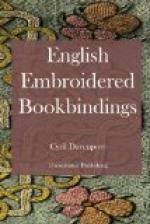Thin pieces of metal are sometimes used alone, caught down at regular intervals by small cross stitches; this is, I believe, called ‘Lizzarding’ (Fig. 3). Metal is also found in the form of ‘guimp,’ in flattened spirals (Fig. 4), and also in the ‘Purl,’ or copper wire covered with silk (Fig. 5), so common on the later satin books (compare p. 46).
[Illustration: FIG. 4. Edging made with a piece of spiral wire hammered flat, appearing like a series of small rings.]
[Illustration: FIG. 5. Loop made of a short length of Purl threaded, the ends drawn together.]
Spangles appear to have been introduced during the reign of Elizabeth, but they were never freely used on velvet, finding their proper place ultimately on the satin books of a later time. The spangles are generally kept in position either by a small section of purl (Fig. 6) or a seed pearl (Fig. 7), in both cases very efficaciously, so that the use of guimp or pearl was not only ornamental but served the same protective purpose as the bosses on a shield, or those so commonly found upon the sides of the stamped leather bindings of mediaeval books.
[Illustration: FIG. 6. Spangle kept in place by a stitch through a short piece of Purl.]
[Illustration: FIG. 7. Spangle kept in place by a stitch through a seed pearl.]
[Illustration: FIG. 8. Binder’s stamp for gold tooling, cut in imitation of a spangle.]
It may be mentioned that the seventeenth-century Dutch binders, Magnus and Poncyn, both of Amsterdam, invented a new tool for gilding on leather bindings, used, of course, in combination with others. This was cut to imitate the small circular spangles of the embroidered books (Fig. 8), and the English and French finishers of a later period used the same device with excellent effect for filling up obtrusive spaces on the sides and backs of their decorative bindings. Thus it may be taken as an axiom that, for the proper working of an embroidered book, except it be tapestry-stitch or tent-stitch, on canvas, which is flat and strong of itself, there should invariably be a liberal use of metal threads, these being not only very decorative in themselves, but also providing a valuable protection to the more delicate needlework at a lower level, and to the material of the ground itself.
The earliest examples of embroidered bindings still existing are not by any means such as would lead to the inference that they were exceptional productions—made when the idea of the application of needlework to the decoration of books was in its infancy. On the contrary, they are instances of very skilled workmanship, so that it is probable that the art was practised at an earlier date than we now have recorded. There are, indeed, frequent notes in ‘Wardrobe Accounts’ and elsewhere of books bound in velvet and satin at a date anterior to any now existing, but there is no mention of embroidered work upon them.




